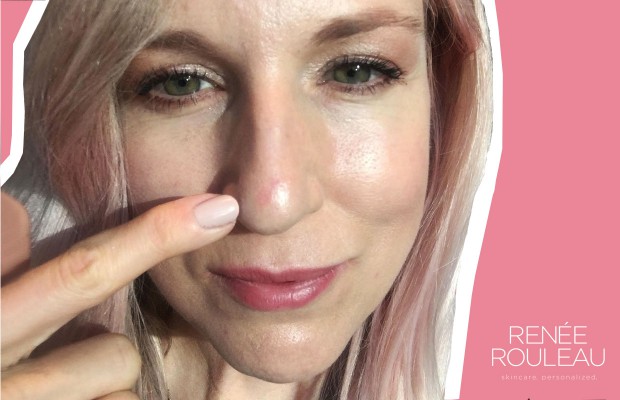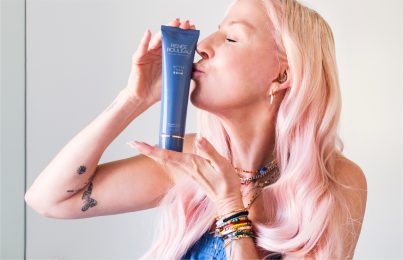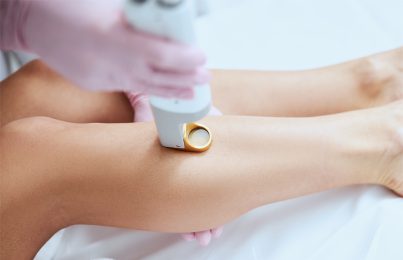Updated 07/26/21. At age 48, I had pre-cancerous cells on my nose. Luckily, it was nothing to worry about because I’ve always been diligent about staying on top of my skin health with regular skin cancer checks. However, I know other people aren’t. What makes matters worse is that the traditional information that’s given out about what to look for doesn’t cover some of the hidden signs (like those that I experienced). This post could very well save your life, so please read this.
When it comes to detecting skin cancer, experts recommend watching your moles to see if they change in color or size over time. If anything looks suspicious, you’ve been told to get them checked by a dermatologist. While this still holds true, there is much less awareness of general changes in the skin that may be hard to detect since they don’t have anything to do with actual moles. This was the case with my skin and the pre-cancerous cells that appeared on my nose.
Important Things to Know About Skin Cancer
Before we talk more about pre-cancerous cells and my personal experience, let’s talk about some important skin cancer statistics. First, skin cancer is the most common form of cancer in the United States and is generally very treatable when caught early. In fact, when detected early, the five-year survival rate for melanoma is 99 percent. This is important to know, seeing as one in five Americans will develop skin cancer by the time they are 70 years old.
What Do Pre-Cancerous Cells Look Like?
Pre-cancerous cells can start out as red patches, and they’re often associated with dryness and flakiness on top. As you can see (ever so slightly) in the picture above, there is a little red patch on the tip of my nose. In my case, there were no signs of dryness so I wasn’t thinking it was much of anything. You see, my moisture barrier was in good shape, so flakiness is not something that would ever show up on my skin unless I had a recent chemical peel or something that’s intended to cause dryness (maintaining a healthy moisture barrier is super important!). After a month of the red patch hanging around, I knew it wasn’t normal, so I scheduled an appointment with a dermatologist here in Austin, Texas where I live.
As I expected, the dermatologist diagnosed it as actinic keratosis (AK for short). There are many stages of skin cancers—actinic keratosis refers to pre-cancerous cells that appear long before it becomes a more dangerous type of cancer. AK is the most common form of precancer and affects more than 58 million Americans.
She used the standard treatment for removal, which was cryotherapy. This is liquid nitrogen that freezes off the affected cells. The procedure burned a bit and I was left with a dark, bumpy scab for about a week. When the scab came off, I was left with another red mark from the discoloration of the burn, similar to a post-breakout mark that people can get after the blemish has disappeared. To smooth out the texture, I used my retinol serum, the Advanced Resurfacing Serum, and the Triple Berry Smoothing Peel.
As an esthetician with 30 years of experience working hands-on with skin, I have had many clients throughout the years, particularly those who were 45 and older, who have had small, red, and flaky patches on their faces. They thought it was dry skin only to find out that all the exfoliation and moisturizer in the world wasn’t going to take care of it. If it’s not caught early, it can enter into the more serious stages of skin cancer and require something called Mohs surgery. This is where the skin is taken out of the nose or face and for some (like my mother), requires serious reconstructive surgery depending on how deep the cancer is. (Skin cancer is not fun. Google it. You’ll see what I mean). In more serious cases, it can lead to death.
What’s important to know is the nose area, in particular, must be given extra attention when caring for your skin. In my experience, the nose seems to be the place that many are prone to getting skin cancer lesions and unhealthy cells as I can personally attest.
I Believe the Nose Is a Vulnerable Area for Three Reasons:
- The nose protrudes and is front and center on the face. This makes it difficult to protect it with sunglasses or a hat. In fact, sunglasses can actually reflect light, which could cause the nose to be exposed to even more sunlight!
- The nose gets sunburned a lot. I have found that when people apply sunscreen, they take their fingertips and go down the sides of their nose onto their cheek area, which means they’re forgetting to apply it directly down the bridge of the nose.
- The oil produced on the nose can degrade sunscreen. The nose is the oiliest area on the face for most people. Oil, or sebum, can break down sunscreen, leaving the skin vulnerable to sun damage. This happens no matter how high the SPF number might be (I use Daily Protection SPF 30 every day. It dries down to a matte finish so it doesn’t degrade as quickly when it comes into contact with my skin’s natural oil).
How Can I Keep My Skin Protected?
There are multiple ways you can keep your skin protected, and I encourage you to be diligent about each one.
- Wear sunscreen. Yes, you’ve probably been told this a million times, but it bears repeating because it’s critical for skin health. Sunscreen should be worn daily (and reapplied generously and consistently). Read how I reapply sunscreen without disturbing my makeup.
- Wear a hat with a UPF rating. This is one of the easiest ways to ensure adequate sun protection. UPF stands for Ultraviolet Protection Factor, and it’s a measurement of sun protection in clothing (regular clothing allows UV light to be transmitted through the weaves of the fabric, especially through natural fibers and lighter colored fabrics). UPF fabric, on the other hand, goes through rigorous testing with light exposure to make sure it’s providing adequate sun protection. Read more about sun-protective clothing (and see some of my favorite sun-protective clothing brands!), here.
- Avoid peak sun hours. This is an easy way to protect yourself against damaging sun exposure. Peak sun hours can be different depending on where you live, but they generally span from 10 am to 4 pm. If possible, avoid prolonged sun exposure during this time.
I encourage you to be really diligent about keeping your nose protected from the sun. I also encourage you to pay attention to any skin changes, whether it’s a mole, a red spot, or skin growth (read more about skin growths and bumps). Finally, it’s of utmost importance that you go see a dermatologist once a year for a skin check, as it can be difficult to notice changes on your own, and they’ll be able to detect things that you may not have noticed yourself. An easy way to remember to get your skin checked is to schedule an annual appointment with a dermatologist on (or near) your birthday—then, you can think of it as getting your birthday suit checked on your birthday!
Healthy skin is everything. I hope you found this post helpful. I also hope it will make you look at your own skin extra closely and check any areas that don’t look quite right.
Next, read up on 5 skincare mistakes that could be making your sunscreen less effective.
Celebrity Esthetician & Skincare Expert
As an esthetician trained in cosmetic chemistry, Renée Rouleau has spent 35 years researching skin, educating her audience, and building an award-winning line of products. Her hands-on experience as an esthetician and trusted skin care expert has created a real-world solution — products that are formulated for nine different types of skin so your face will get exactly what it needs to look and feel its best. Trusted by celebrities, editors, bloggers, and skincare obsessives around the globe, her vast real-world knowledge and constant research are why Marie Claire calls her “the most passionate skin practitioner we know.”




Comments:
Thank you for the very informative information on Actinic Keratosis. Appreciate!
Posted By: Esther Botha |
Thank you for reading!
Posted By: Ella Stevenson |